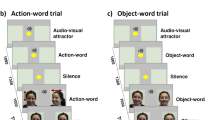Abstract
Because human languages vary in sound and meaning, children must learn which distinctions their language uses. For speech perception, this learning is selective: initially infants are sensitive to most acoustic distinctions used in any language1,2,3, and this sensitivity reflects basic properties of the auditory system rather than mechanisms specific to language4,5,6,7; however, infants' sensitivity to non-native sound distinctions declines over the course of the first year8. Here we ask whether a similar process governs learning of word meanings. We investigated the sensitivity of 5-month-old infants in an English-speaking environment to a conceptual distinction that is marked in Korean but not English; that is, the distinction between ‘tight’ and ‘loose’ fit of one object to another9,10. Like adult Korean speakers but unlike adult English speakers, these infants detected this distinction and divided a continuum of motion-into-contact actions into tight- and loose-fit categories. Infants' sensitivity to this distinction is linked to representations of object mechanics11 that are shared by non-human animals12,13,14. Language learning therefore seems to develop by linking linguistic forms to universal, pre-existing representations of sound and meaning.
This is a preview of subscription content, access via your institution
Access options
Subscribe to this journal
Receive 51 print issues and online access
$199.00 per year
only $3.90 per issue
Buy this article
- Purchase on Springer Link
- Instant access to full article PDF
Prices may be subject to local taxes which are calculated during checkout



Similar content being viewed by others
References
Jusczyk, P. W. The Discovery of Spoken Language (MIT, Cambridge Massachusetts, 1997)
Kuhl, P. K. Early linguistic experience and phonetic perception: Implications for theories of developmental speech perception. J. Phonetics 21, 125–139 (1993)
Eimas, P. D., Siqueland, E. R., Jusczyk, P. & Vigorito, J. Speech perception in infants. Science 171, 303–306 (1971)
Hauser, M. D. The Evolution of Communication (MIT, Cambridge Massachusetts, 1996)
Wyttenbach, R. A., May, M. L. & Hoy, R. R. Categorical perception of sound frequency by crickets. Science 273, 1542–1544 (1996)
Kuhl, P. K. & Miller, J. D. Speech perception by the chinchilla: Voiced-voiceless distinction in alveolar plosive consonants. Science 190, 69–72 (1975)
Kuhl, P. K. in Categorical Perception: The Groundwork of Cognition (ed. Harnad, S.) 355–386 (Cambridge Univ. Press, New York, 1987)
Werker, J. F. & Tees, R. C. Cross-language speech perception: Evidence for perceptual reorganization during the first year of life. Infant Behav. Dev. 7, 49–63 (1984)
Choi, S. & Bowerman, M. Learning to express motion events in English and Korean: The influence of language-specific lexicalization patterns. Cognition 41, 83–121 (1991)
McDonough, L., Choi, S. & Mandler, J. M. Understanding spatial relations: Flexible infants lexical adults. Cogn. Psychol. 46, 229–259 (2003)
Spelke, E. S. Principles of object perception. Cogn. Sci. 14, 29–56 (1990)
Hauser, M. D. A nonhuman primate's expectations about object motion and destination: The importance of self-propelled movement and animacy. Dev. Sci. 1, 31–37 (1998)
Santos, L. R. & Hauser, M. D. A non-human primate's understanding of solidity: Dissociations between seeing and acting. Dev. Sci. 5, F1–F7 (2002)
Santos, L. R. ‘Core knowledges’: a dissociation between spatiotemporal knowledge and contact-mechanics in a non-human primate? Dev. Sci. 7, 167–174 (2004)
Bowerman, M. in Language and Space. Language, Speech, and Communication (eds Bloom, P. & Peterson, M. A.) 385–436 (MIT, Cambridge Massachusetts, 1996)
Choi, S., McDonough, L., Bowerman, M. & Mandler, J. M. Early sensitivity to language-specific spatial categories in English and Korean. Cogn. Dev. 14, 241–268 (1999)
Bowerman, M. & Choi, S. in Language Acquisition and Conceptual Development (eds Bowerman, M. & Levinson, S.) (Cambridge Univ. Press, Cambridge, UK, 2001)
Casasola, M., Cohen, L. B. & Chiarello, E. Six-month-old infants' categorization of containment spatial relations. Child Dev. 74, 679–693 (2003)
Casasola, M. & Cohen, L. B. Infant categorization of containment, support and tight-fit spatial relationships. Dev. Sci. 5, 247–264 (2002)
Bowerman, M. & Levinson, S. (eds) Language Acquisition and Conceptual Development (Cambridge Univ. Press, Cambridge, 2001)
Whorf, B. L. Language, Thought, and Reality (MIT, Cambridge, 1956)
Bornstein, M. H. in Measurement of Audition and Vision in the First Year of Postnatal Life: A Methodological Overview (eds Gottlieb, G. & Krasnegor, N. A.) 253–300 (Westport, Connecticut, Ablex, 1985)
Baillargeon, R. in Advances in Infancy Research (ed. Lipsitt, C. R.-C. L. P.) 305–371 (Ablex, Norwood, 1995)
Hauser, M., Chomsky, N. & Fitch, W. T. The faculty of language: What is it, who has it, and how did it evolve? Science 298, 1569–1579 (2002)
Werker, J. F. in An Invitation to Cognitive Science (eds Gleitman, L. & Liberman, M.) 87–106 (MIT, Cambridge, 1995)
Acknowledgements
We thank E. Blass, K. Condry, J. Goodman and L. Markson for comments and suggestions. This work was supported by grants from the NIH and NIH NRSA.
Author information
Authors and Affiliations
Corresponding author
Ethics declarations
Competing interests
The authors declare that they have no competing financial interests.
Supplementary information
Supplementary Movie 1
The three movies depict video versions of three different habituation trials that were used in Experiment 1 and 2. (MP4 1095 kb)
Supplementary Movie 2
The three movies depict video versions of three different habituation trials that were used in Experiment 1 and 2. (MP4 1294 kb)
Supplementary Movie 3
The three movies depict video versions of three different habituation trials that were used in Experiment 1 and 2. (MP4 1149 kb)
Rights and permissions
About this article
Cite this article
Hespos, S., Spelke, E. Conceptual precursors to language. Nature 430, 453–456 (2004). https://doi.org/10.1038/nature02634
Received:
Accepted:
Issue Date:
DOI: https://doi.org/10.1038/nature02634
This article is cited by
-
Cognition, Representations and Embodied Emotions: Investigating Cognitive Theory
Erkenntnis (2014)
-
What Languages Tell Us About the Structure of the Human Mind
Cognitive Computation (2012)
-
SEON: a pyramid of ontologies for software evolution and its applications
Computing (2012)
Comments
By submitting a comment you agree to abide by our Terms and Community Guidelines. If you find something abusive or that does not comply with our terms or guidelines please flag it as inappropriate.



